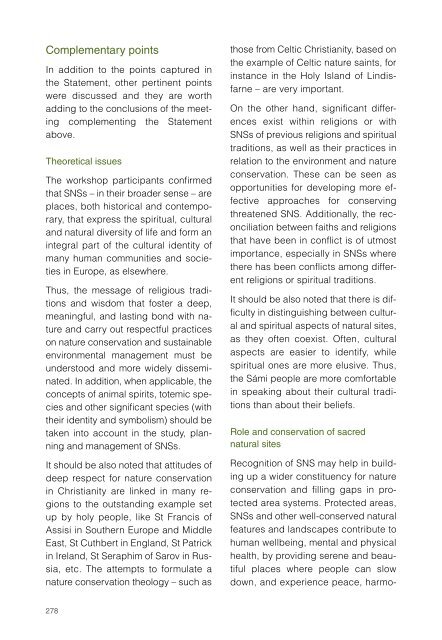The Diversity of Sacred Lands in Europe - IUCN
The Diversity of Sacred Lands in Europe - IUCN
The Diversity of Sacred Lands in Europe - IUCN
Create successful ePaper yourself
Turn your PDF publications into a flip-book with our unique Google optimized e-Paper software.
Complementary po<strong>in</strong>ts<br />
In addition to the po<strong>in</strong>ts captured <strong>in</strong><br />
the Statement, other pert<strong>in</strong>ent po<strong>in</strong>ts<br />
were discussed and they are worth<br />
add<strong>in</strong>g to the conclusions <strong>of</strong> the meet<strong>in</strong>g<br />
complement<strong>in</strong>g the Statement<br />
above.<br />
<strong>The</strong>oretical issues<br />
<strong>The</strong> workshop participants confirmed<br />
that SNSs – <strong>in</strong> their broader sense – are<br />
places, both historical and contemporary,<br />
that express the spiritual, cultural<br />
and natural diversity <strong>of</strong> life and form an<br />
<strong>in</strong>tegral part <strong>of</strong> the cultural identity <strong>of</strong><br />
many human communities and societies<br />
<strong>in</strong> <strong>Europe</strong>, as elsewhere.<br />
Thus, the message <strong>of</strong> religious traditions<br />
and wisdom that foster a deep,<br />
mean<strong>in</strong>gful, and last<strong>in</strong>g bond with nature<br />
and carry out respectful practices<br />
on nature conservation and susta<strong>in</strong>able<br />
environmental management must be<br />
understood and more widely dissem<strong>in</strong>ated.<br />
In addition, when applicable, the<br />
concepts <strong>of</strong> animal spirits, totemic species<br />
and other significant species (with<br />
their identity and symbolism) should be<br />
taken <strong>in</strong>to account <strong>in</strong> the study, plann<strong>in</strong>g<br />
and management <strong>of</strong> SNSs.<br />
It should be also noted that attitudes <strong>of</strong><br />
deep respect for nature conservation<br />
<strong>in</strong> Christianity are l<strong>in</strong>ked <strong>in</strong> many regions<br />
to the outstand<strong>in</strong>g example set<br />
up by holy people, like St Francis <strong>of</strong><br />
Assisi <strong>in</strong> Southern <strong>Europe</strong> and Middle<br />
East, St Cuthbert <strong>in</strong> England, St Patrick<br />
<strong>in</strong> Ireland, St Seraphim <strong>of</strong> Sarov <strong>in</strong> Russia,<br />
etc. <strong>The</strong> attempts to formulate a<br />
nature conservation theology – such as<br />
those from Celtic Christianity, based on<br />
the example <strong>of</strong> Celtic nature sa<strong>in</strong>ts, for<br />
<strong>in</strong>stance <strong>in</strong> the Holy Island <strong>of</strong> L<strong>in</strong>disfarne<br />
– are very important.<br />
On the other hand, significant differences<br />
exist with<strong>in</strong> religions or with<br />
SNSs <strong>of</strong> previous religions and spiritual<br />
traditions, as well as their practices <strong>in</strong><br />
relation to the environment and nature<br />
conservation. <strong>The</strong>se can be seen as<br />
opportunities for develop<strong>in</strong>g more effective<br />
approaches for conserv<strong>in</strong>g<br />
threatened SNS. Additionally, the reconciliation<br />
between faiths and religions<br />
that have been <strong>in</strong> conflict is <strong>of</strong> utmost<br />
importance, especially <strong>in</strong> SNSs where<br />
there has been conflicts among different<br />
religions or spiritual traditions.<br />
It should be also noted that there is difficulty<br />
<strong>in</strong> dist<strong>in</strong>guish<strong>in</strong>g between cultural<br />
and spiritual aspects <strong>of</strong> natural sites,<br />
as they <strong>of</strong>ten coexist. Often, cultural<br />
aspects are easier to identify, while<br />
spiritual ones are more elusive. Thus,<br />
the Sámi people are more comfortable<br />
<strong>in</strong> speak<strong>in</strong>g about their cultural traditions<br />
than about their beliefs.<br />
Role and conservation <strong>of</strong> sacred<br />
natural sites<br />
Recognition <strong>of</strong> SNS may help <strong>in</strong> build<strong>in</strong>g<br />
up a wider constituency for nature<br />
conservation and fill<strong>in</strong>g gaps <strong>in</strong> protected<br />
area systems. Protected areas,<br />
SNSs and other well-conserved natural<br />
features and landscapes contribute to<br />
human wellbe<strong>in</strong>g, mental and physical<br />
health, by provid<strong>in</strong>g serene and beautiful<br />
places where people can slow<br />
down, and experience peace, harmo-<br />
278













